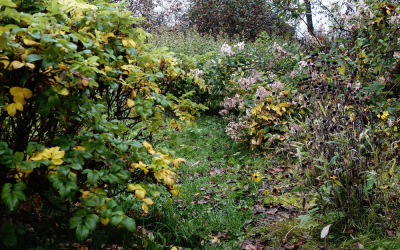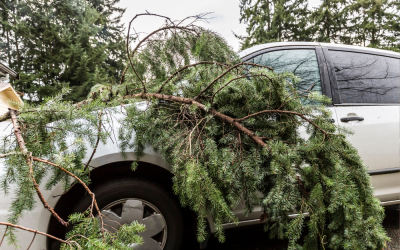When you are felling a tree, safety is paramount, so much so that it is highly recommended that you use a trained a competent tree surgeon to carry out the operation. There are many things to take into account and knowing the correct technique is vital if you are to avoid damaging property or more importantly seriously injuring or killing yourself and others around you! This post will outline the basic methods employed when felling a tree and the safety precautions required. Remember safety is paramount!
Minimum personal protective equipment recommended:
- Safety helmet (which should incorporate face guard and ear defenders)
- Gloves
- Chainsaw protective trousers/leggings (to provide cut protection in case of contact with legs)
- Chainsaw protective boots (with steel toe caps)
The chainsaw:
- This should have all the necessary safety guards such as a fully functional chain break which will stop the chain if kick back occurs
- A chain catcher which stops the chain from hitting you if it snaps
- The saw should also be sharp as a blunt chainsaw will not cut properly and could end up becoming trapped.
Assess the site of the tree you want to remove
For any tree it is important to ensure there is enough space for the tree to fall into to avoid hitting anything. By estimating the height of the tree you can then pace this out on the ground before starting. If you are satisfied that there is enough room then you can move onto the next step. Before beginning any cutting you should make sure you have adequate escape routes from the base of the tree. These are at a 45 degree angle from where the felling cut takes place.
Assess the tree itself
It is crucial that you look at the tree and make sure that it is not leaning heavily in one direction, or overloaded with branches one side, as this will make the tree fall one way no matter how you cut the trunk. Make sure there are no dead or broken branches, or branches that have fallen off but are being held up by other branches. Trying to fell a tree in that condition will most likely result in a branch falling on you.
Making the Cuts
The first two cuts take a notch out of the tree facing the direction you want it to fall (make the downward facing cut first). The first two cuts should be about a fifth of the way into the tree. Once you have a notch, line up the third cut just above the middle of the notch, as in the diagram. If it is a large tree that you are cutting down, you might want to use a wedge to hold open the third cut. As soon as the saw is far enough in, hammer in a wedge to stop the tree from leaning back and trapping your saw. It can also help to attach a length of rope high up on the stem of the tree and have someone to pull the line once you have completed the cuts to aid in the direction of fall (make sure the person pulling is at least one and half times the length of the tree away to avoid being hit!) As soon as the tree starts leaning, pull out the saw, put the chain brake on and walk down one of your escape routes. Make sure to keep your eyes on the tree while moving away from it, just in case it falls in the wrong direction. It is always best to have someone looking out for you when felling a tree, as they might spot danger quicker than you and get you out of harm’s way.
All trees react differently when being cut. For example some are more brittle than others and there could be also unseen rot in the base of the stem which when cut into could lead to the tree falling in any direction regardless of the correct methods employed. Please remember that it is a potentially fatal operation if carried out incorrectly.
Contact Us For Help With Your Tree Today
If you are faced with a tree felling job that you aren’t sure about or don’t have the proper tools and safety gear for, then give us a call on 0161 300 9789 or contact us online and we will be happy to help.



